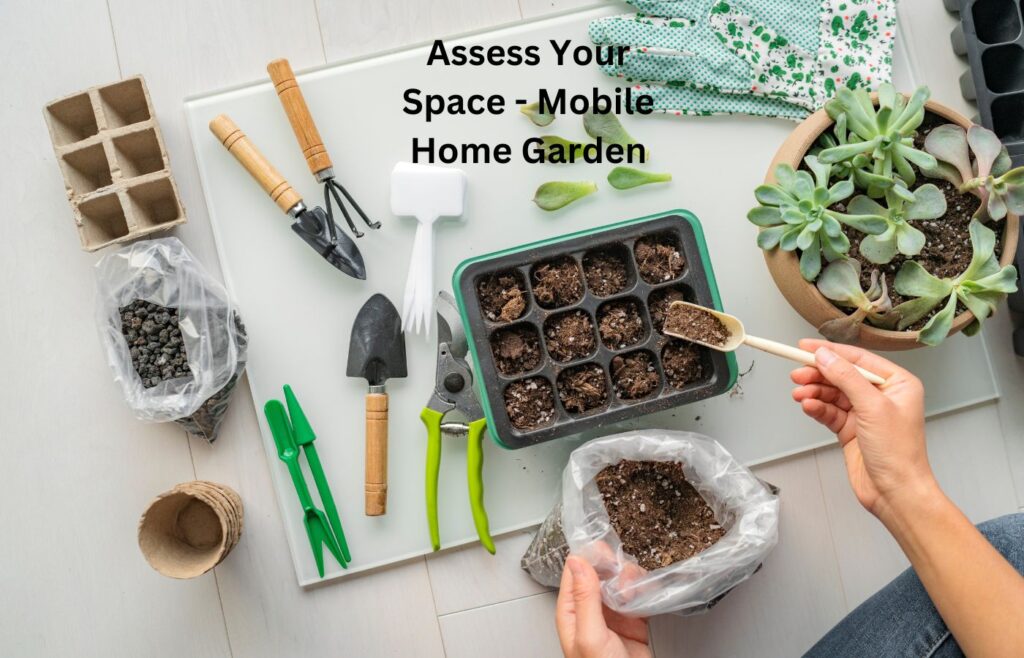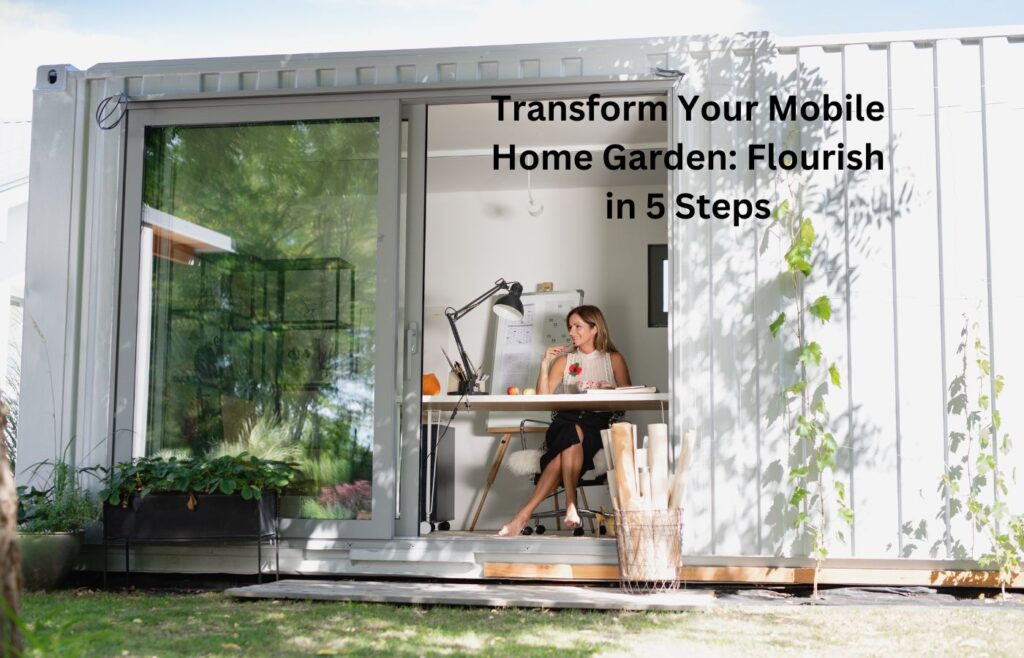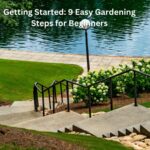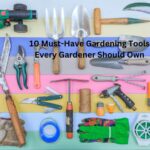Introduction – Mobile Home Garden
Embarking on the adventure of remodeling your mobile home garden may be both exciting and daunting. While mobile home residing gives flexibility and affordability, it often comes with restrained outside areas, providing particular challenges for gardening lovers. However, with the right strategies and a piece of creativity, you can flip even the smallest patch of land right into a lush and thriving oasis.
In this comprehensive guide, we can delve into 5 crucial steps to help you release the entire capability of your mobile home garden. From assessing your space and making plans for your format to selecting the proper plants and implementing smart design strategies, every step is designed to empower you to create a lawn that no longer only enhances the classy appeal of your own home but also offers a sanctuary for rest and rejuvenation.
Whether you are an amateur gardener or have years of experience, this guide will equip you with the information and thought needed to embark on your gardening journey with self-assurance. By following these steps, you’ll learn how to maximize every square inch of your mobile home garden, cultivate a wide variety of plant life, and create a sustainable and exquisite outside space that you can revel in for future years. Get prepared to transform your mobile home garden and cultivate a green haven that reflects your particular fashion and personality.
Assess Your Space – Mobile Home Garden

Assessing your space is the critical first step in growing a successful mobile home garden. Mobile home garden living often copes with limited outdoor space, so it’s vital to make the maximum of what you have got to be had. Here’s the way to check your area effectively:
Sunlight Exposure
Start by staring at how sunlight moves across your lawn during the day. Note which areas acquire complete sun, partial solar, or color. Most flowers require at least six hours of sunlight each day to thrive, so understanding your garden’s sunlight patterns will help you pick the right flora for each place.
Soil Quality
Test your soil to determine its pH stage and nutrient content. You can purchase soil checking-out kits at garden centers or contact your local agricultural extension office for assistance. Understanding your soil’s composition will help you pick flora that can be nicely desirable to its situations and pick out any amendments or fertilizers needed to improve soil health.
Available Space
Measure the scale of your lawn area and pay attention to any obstacles or features, together with trees, fences, or systems. Consider how much area you have for planting beds, pathways, seating regions, and different factors. Keep in thoughts that mobile home garden frequently have limited floor space, so maximizing vertical developing space can be especially useful.
Climate Considerations
Take under consideration your nearby climate and weather styles whilst assessing your area. Consider elements that include common temperatures, frost dates, and precipitation levels. Choose plant life that can be nicely appropriate to your climate area to ensure their long-term success in your mobile home garden.
Mobility and Accessibility
Consider how without difficulty you may access and flow around your lawn area, mainly if you have mobility troubles or physical barriers. Design pathways and planting areas with accessibility in mind, making sure that you can reach all areas of your garden without difficulty.
By cautiously assessing your mobile home garden space, you’ll gain valuable insights into its particular traits and demanding situations. Armed with this expertise, you’ll be better equipped to make informed selections about plant choice, format design, and garden maintenance, placing the level for a hit gardening revel.
Plan Your Layout – Mobile Home Garden

Planning your layout is an essential step in growing a purposeful and aesthetically attractive mobile home garden. With restrained areas available, cautious consideration ought to be given to the way you set up plants, pathways, and different lawn capabilities. Here’s how to plan your format efficaciously:
Take Measurements
Start by way of measuring the size of your lawn area, such as any current structures, such as decks or patios. Use those measurements to create a hard comic strip or scale drawing of your garden space. This will serve as the basis for your layout plan.
Consider Traffic Flow
Think about how you and others will flow through the garden. Designate pathways that permit the smooth right of entry to specific areas of the lawn without trampling on flowers. Pathways may be made from substances which include gravel, stepping stones, or mulch, depending on your options and budget.
Define Functional Zones
Divide your lawn space into purposeful zones primarily based on how you propose to apply it. For example, you can need to designate regions for planting beds, seating areas, or ornamental functions like fountains or sculptures. Consider how each region will contribute to the overall functionality and entertainment of your mobile home garden.
Maximize Vertical Space
Mobile home gardens regularly have confined floor space, so it is important to make the most of vertical space. Consider putting in trellises, baskets, or wall-established planters to grow hiking flora, herbs, or flowers vertically. Vertical gardening no longer best maximizes area but also adds visible interest to your mobile home garden.
Create Focal Points
Incorporate focal points into your garden format to draw the eye and create visual interest. Focal factors can encompass a specimen plant, a decorative sculpture, or a seating place with a beautiful view. Place focal factors strategically to beautify the overall layout and create an experience of balance and harmony on your lawn.
Balance Form and Function
Strive for a balance between form and feature in your mobile home garden format. While aesthetics are crucial, prioritize capability and practicality to make sure that your mobile home garden meets your wishes and way of life. Consider elements such as upkeep requirements, water performance, and ease of getting the right of entry while designing your format.
Think Seasonally
Plan your layout with seasonal adjustments in mind. Choose flora as a good way to provide a year-round hobby and consider how your lawn will look and its characteristics in one-of-a-kind seasons. Incorporate evergreen flora, ornamental grasses, and seasonal blooms to keep your mobile home garden vibrant and welcoming over the year.
Experiment and Adapt
Don’t be afraid to experiment with special layout thoughts and make modifications as needed. Gardening is a dynamic method, and your garden format might also evolve over the years as you analyze what works exceptionally in your space and personal preferences. Be open to trying new vegetation, layout elements, and layout configurations to create a garden that genuinely displays your fashion and personality.
By cautiously planning your mobile home garden format, you could make the most of your confined space and create a beautiful and functional outdoor oasis. Consider the precise characteristics of your lawn space, prioritize functionality and practicality, and permit your creativity to guide you as you design a mobile home garden that complements your mobile home lifestyle.
Choose the Right Plants – Mobile Home Garden

Choosing the right plant life is vital for developing a thriving mobile home garden. With confined areas and particular growing conditions, it is important to pick out flowers that are nicely suitable to your environment and will flourish for your mobile home garden. Here’s a way to select the proper plant life for your mobile home garden:
Consider Your Climate
Start by considering your nearby weather and growing conditions. Choose flowers that might be suitable for your hardiness sector and can tolerate the temperature fluctuations and weather styles of your location. Your neighborhood lawn center or agricultural extension office can offer valuable data approximately the best vegetation in your weather.
Assess Sunlight Levels
Evaluate the daylight exposure to your lawn and pick vegetation that healthy your mobile home garden’s light situations. Some plants require complete sun (at least 6 hours of direct sunlight in step with the day), while others thrive in partial color or full coloration. Take notice of which areas of your garden get hold of the maximum sunlight and pick out plant life for this reason.
Understand Soil Conditions
Take into account the soil and drainage of your garden whilst selecting flowers. Some vegetation decides on properly-drained soil, at the same time as others thrive in wet or boggy situations. Conduct a soil test to decide your soil’s pH level and nutrient content material, and pick plant life that can be like-minded with your soil kind.
Choose Low-Maintenance Varieties
Opt for low-upkeep flowers that require minimum care and attention, especially when you have a hectic timetable or are new to gardening. Look for drought-tolerant flora, local species, and types that are proof against pests and illnesses. These plant life will thrive with minimum intervention, permitting you to enjoy your mobile home garden without consistent upkeep.
Maximize Vertical Space
In a small mobile home garden, maximizing vertical space is fundamental. Choose flora that can develop vertically, such as mountain climbing vines, tall grasses, and trellis-educated vegetables. This not only maximizes growing space but also provides a visible hobby and dimension to your mobile home garden.
Select Multi-Purpose Plants
Choose plants that serve more than one function in your garden, consisting of imparting beauty, attracting pollinators, and generating food or herbs. For instance, do not forget to plant flowering herbs like lavender or sage, which not only upload color and perfume to your garden but additionally attract useful bugs and may be used for culinary functions.
Create a Diversity of Plants
Aim for a diverse blend of plant life in your garden to create a balanced ecosystem and beautify biodiversity. Incorporate quite a few flowers, shrubs, herbs, and veggies to provide meals and habitat for various beneficial insects, birds, and other flora and fauna. Diversity additionally enables prevent pest and sickness problems through lowering monoculture planting.
Choose Container-Friendly Plants
If the area is confined to your mobile home garden, remember to develop flowers in packing containers. Choose compact or dwarf sorts of vegetation that might be well-appropriate for container gardening, inclusive of patio tomatoes, dwarf citrus bushes, and ornamental grasses. Containers may be placed on patios, decks, or balconies to maximize developing space.
Think About Seasonal Interest: Select flora that provides year-round interest on your lawn, with an aggregate of evergreen foliage, seasonal blooms, and converting foliage colorations. Incorporate flowers with special bloom times to make certain that your lawn looks colorful and colorful for the duration of the 12 months.
Research Plant Compatibility
Before planting, study the compatibility of different plant species to ensure they may thrive together in your garden. Some vegetation might also have allelopathic residences that inhibit the boom of other vegetation, at the same time as others may also compete for sources or have specific water and nutrient necessities. Plan your plantings therefore to create harmonious developing situations for all of your plants.
By carefully selecting flowers that are well-suitable for your mobile home garden’s particular situations, you could create a lovely and thriving outdoor space that enhances your home and way of life. Consider factors that include climate, daylight publicity, soil exceptional, and upkeep requirements while choosing flora, and goals for a diverse mix of species to create a balanced and biodiverse atmosphere. With the right vegetation, your cmobile home gardenwill flourish and provide joy and beauty for future years.
Implement Smart Design Strategies – Mobile Home Garden

Implementing clever design strategies is critical for maximizing the ability of your mobile home garden and making the most of restrained space. By incorporating thoughtful design elements, you can create a useful, lovely, and sustainable outdoor oasis. Here are some clever layout techniques to keep in mind:
Raised Beds and Containers
Utilize raised beds and packing containers to develop flora in small areas. Raised beds provide stepped forward drainage, better soil high-quality, and easier access for planting and maintenance. Containers are versatile and may be placed on patios, decks, or balconies to maximize developing space. Choose compact or dwarf forms of flora that might be well-acceptable to container gardening, consisting of herbs, veggies, and vegetation.
Vertical Gardening
Make use of the vertical area by incorporating trellises, arbors, and wall-established planters into your lawn design. Vertical gardening lets you develop hiking plant life, vines, and trailing vegetation, maximizing the growing area and adding visual interest to your lawn. Train plants to develop vertically the use of supports which include bamboo stakes, wire mesh, or trellis netting.
Companion Planting
Practice accomplice planting to maximize the productiveness and health of your lawn. Companion planting entails growing like-minded vegetation together to gain every other, consisting of repelling pests, attracting useful insects, or improving soil fertility. Research associate planting combinations that work properly in your climate and growing conditions and incorporate them into your lawn layout.
Mulching and Composting
Use mulch and compost to improve soil health, maintain moisture, and suppress weeds in your garden. Mulching with natural substances consisting of straw, wood chips, or shredded leaves enables conserve water, alter soil temperature, and reduce erosion. Composting natural waste along with kitchen scraps, lawn particles, and grass clippings produces nutrient-wealthy compost that enriches the soil and supports plant boom.
Water-Efficient Design
Design your lawn with water performance in mind to preserve water and decrease irrigation wishes. Choose drought-tolerant plant life that requires minimal watering once set up and group flora with comparable water needs collectively. Install a drip irrigation device or soaker hoses to supply water without delay to plant roots and minimize water waste. Incorporate rainwater harvesting strategies consisting of rain barrels or rain gardens to capture and keep rainwater for irrigation.
Integrate Edible Landscaping
Incorporate edible vegetation into your lawn design to create a beautiful and effective landscape. Integrate herbs, greens, fruit bushes, and edible plants into ornamental plantings to maximize area and provide sparkling, homegrown produce to your own family. Choose safe-to-eat plant life that can be nicely suited to your climate and growing conditions and incorporate them into present garden beds or committed fit for human consumption gardens.
Create Microclimates
Take advantage of microclimates within your garden to develop a much wider variety of plant life and make the growing season. Microclimates are small regions inside your lawn that have precise environmental situations, which include temperature, sunlight, and moisture stages. Plant warmth-loving crops in sunny, sheltered spots and bloodless-sensitive flowers in included areas with less publicity to wind and frost.
Use Sustainable Materials
Choose sustainable materials for lawn functions along with raised beds, pathways, and hardscaping elements. Opt for locally sourced, recycled, or renewable substances each time viable to reduce environmental impact and assist sustainable practices. Consider substances that include reclaimed wood, recycled plastic lumber, permeable pavers, and natural stone in your lawn initiatives.
By enforcing smart design strategies to your mobile home garden, you may create a lovely, effective, and sustainable outside space that maximizes limited assets and enhances your private home and lifestyle. Consider factors that include raised beds, vertical gardening, accomplice planting, water efficiency, fit-for-human consumption landscaping, microclimates, and sustainable substances when planning and designing your garden. With considerate design and careful implementation, your mobile home garden will flourish and provide enjoyment for years to come.
Maintain and Enjoy Your Garden – Mobile Home Garden

Maintaining and playing with your mobile home garden is essential for ensuring its lengthy-time period success and maximizing your enjoyment of the out-of-door space. By setting up an ordinary protection habit and taking time to understand the beauty and quietness of your lawn, you may create a thriving oasis that brings joy and relaxation to your mobile home way of life. Here are some pointers for retaining and taking part in your garden:
Establish a Maintenance Schedule
Develop an everyday maintenance timetable to preserve your garden looking first-class year-round. This timetable ought to encompass responsibilities inclusive of watering, fertilizing, weeding, pruning, and deadheading. Break down large tasks into smaller, achievable steps and unfold them out through the years to prevent weight down.
Water Wisely
Water your lawn deeply and rarely to inspire wholesome root increase and reduce water waste. Use a drip irrigation device or soaker hoses to deliver water at once to plant roots and minimize evaporation. Water early in the morning or overdue in the night to lessen water loss because of evaporation and make certain most absorption through flowers.
Fertilize Appropriately
Feed your plant life with organic fertilizers or compost to provide vital nutrients for healthy growth and blooming. Avoid over-fertilizing, as this can result in nutrient imbalances and environmental pollution. Follow the encouraged software quotes for each sort of fertilizer and apply them at appropriate times throughout the growing season.
Weed Regularly
Keep weeds in test using frequently pulling or hoeing them out of your garden beds. Weeds compete with your plant life for water, vitamins, and daylight, so it is essential to cast off them right away to prevent them from taking on your garden. Consider the use of mulch to suppress weed boom and preserve soil moisture.
Prune and Deadhead
Prune your flora as had to take away useless or diseased branches, form increase, and sell airflow and sunlight penetration. Deadhead spent vegetation to inspire continuous blooming and prevent seed production. Regular pruning and deadheading help hold the health and appearance of your garden vegetation and extend their blooming length.
Monitor for Pests and Diseases
Keep an eye out for signs and symptoms of pests and illnesses in your lawn and take movement promptly to prevent them from inflicting tremendous harm. Inspect your flora regularly for symptoms such as yellowing leaves, holes in foliage, or uncommon spots or discoloration. Consider the use of herbal or natural pest management strategies each time possible to minimize harm to beneficial insects and flora and fauna.
Take Time to Relax and Enjoy
Finally, consider taking time to relax and experience the beauty and quietness of your garden. Spend time sitting or taking walks on your lawn, observing the flowers, being attentive to the sounds of nature, and connecting with the outdoors. Use your garden as a peaceful retreat wherein you may unwind, de-pressure, and recharge your batteries after a hectic day.
By organizing an ordinary preservation routine and taking time to revel in the splendor of your garden, you can create a welcoming outdoor area that enhances your mobile home lifestyle and brings pleasure and rest to your normal existence. Embrace the possibility of connecting with nature and relish the simple pleasures of gardening for your mobile home garden.
Conclusion – Mobile Home Garden
In conclusion, creating and retaining a mobile home garden is a worthwhile endeavor that complements each the beauty of your home and your general high-quality of life. By following the steps mentioned in this manual—assessing your area, making plans for your format, deciding on the right plant life, imposing smart design strategies, and retaining and enjoying your lawn—you may transform even the smallest door space into a colorful and thriving oasis.
Your mobile home lawn is more than just a series of plant life; it is a reflection of your creativity, personality, and connection to nature. Whether you are growing plant life, herbs, greens, or a combination of all 3, your lawn affords a sanctuary where you can relax, recharge, and find peace amidst the hustle and bustle of everyday lifestyles.
As you continue to nurture and care for your garden, remember to take time to appreciate the splendor and quietness it brings to your mobile home lifestyle. Whether you are tending to flowers, enjoying a meal outdoors, or soaking in the attractions and sounds of nature, your garden is a place wherein memories are made and moments are cherished. Embrace the possibility of domesticating your very own little slice of paradise and permit your mobile home garden to inspire and pleasure you for years to come.
What are the best plants for a mobile home garden?
Opt for low-maintenance plants suited to your climate, like succulents, herbs, dwarf fruit trees, and compact flowering perennials. Native plants often thrive in mobile home gardens due to their resilience.
How do I deal with soil quality issues in my mobile home garden?
Test your soil to identify its pH and nutrient levels. Amend soil as needed with organic matter like compost or peat moss to improve its structure and fertility.
What are some water-saving tips for a mobile home garden?
Install a drip irrigation system or soaker hoses to deliver water directly to plant roots, minimizing evaporation. Mulch around plants to retain moisture and reduce watering frequency.
How can I maintain my mobile home garden during the colder months?
Consider planting cold-hardy varieties and protect sensitive plants with frost blankets or move them indoors. Mulch around plants to insulate roots and help retain soil warmth.
How do I attract pollinators to my mobile home garden?
Plant a variety of native flowers and herbs that attract bees, butterflies, and other pollinators. Provide water sources like shallow dishes or birdbaths, and avoid using pesticides harmful to beneficial insects.
What are some creative design ideas for a mobile home garden?
Incorporate vertical elements like trellises or hanging baskets, create functional zones with seating areas or raised beds, and add decorative touches such as lighting or garden art to personalize your space.
How do I deal with pests and diseases in my mobile home garden?
Monitor plants regularly for signs of pests or diseases and take preventive measures like proper spacing, good air circulation, and practicing crop rotation. Use natural pest control methods like neem oil or insecticidal soap when necessary.
The article “Transform Your Mobile Home Garden: Flourish in 5 Steps” is written by HomeGardenIdeas.com. Our team of passionate writers and experts shares tips and inspiration on gardening, home improvement, and design to help you create your dream space.








Lots of info here! Thanks